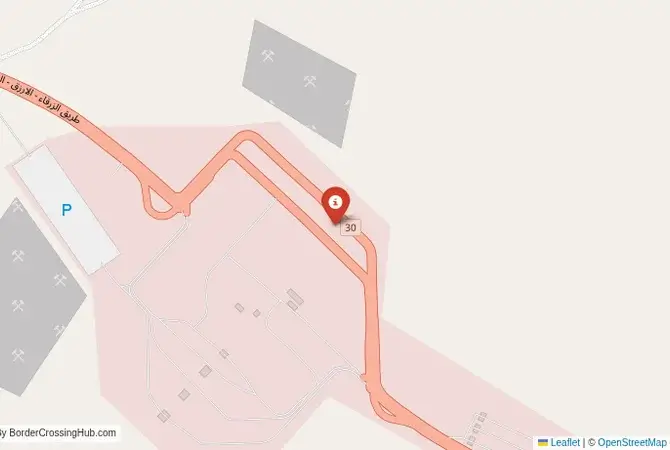
Approximate Border Location
Border Countries
- 🇯🇴Jordan
- 🇸🇦Saudi Arabia
Border Cities
- 🇯🇴Umari (Al-Omari)
- 🇸🇦Umari (Saudi)
Wait Times
30-60 min for pedestrians/vehicles
Operating Hours
Open 24 hours
Crossing Types
Pedestrians, vehicles, commercial
Border Type
Land crossing via road
Peak Times
Mornings (7-10 AM), weekends
Daily Crossings
~4000 travelers/vehicles
Currency Exchange
Available near Umari (JOD, SAR)
Safety Information
Generally safe, desert hazards
Languages Spoken
Arabic, English
Accessibility Features
Ramps, assistance
About Umari (Al-Omari) & Umari (Saudi)
A Crossing in the Eastern Desert
The border crossing connecting the area near Al-Omari in Jordan with Al-Umari in Saudi Arabia is a journey into the vast, arid, and beautiful landscape of the eastern Jordanian desert. This is a major international checkpoint, but its remote location gives it a unique character. It is a modern facility in the middle of a vast, empty wilderness. To cross here is to travel a route that is a vital artery for trade and for the millions of pilgrims who travel to the holy cities of Mecca and Medina. It is a passage defined by the stark beauty of the desert, the constant flow of commercial trucks, and the deep religious significance of the journey for so many of its travelers.
Operational Details
This checkpoint connects the Zarqa Governorate of Jordan with the Al-Jawf Province of Saudi Arabia. It is a major international crossing, open 24/7 to all passenger cars, buses, and commercial freight. The facility is large and modern on both sides, designed to handle a significant volume of traffic. It is the primary route for goods moving between Jordan and the Gulf states, and it is a key route for the Hajj and Umrah pilgrimages. The crossing can be very busy, especially with freight traffic and during the pilgrimage seasons.
Before Crossing
Crossing borders gets messy sometimes, think political flare-ups or gates shutting fast. Good travel insurance is a must for handling doctor visits, trip disruptions, or security scares. Don’t get caught unprepared. To find a policy that’s got your back, check out reliable plans today for peace of mind.
A History of a Desert Frontier
The history of this region is the history of the Bedouin tribes and the ancient caravan routes. For centuries, this was a remote and sparsely populated desert. The modern border was established in the 20th century. The crossing at Al-Omari grew in importance with the development of the modern highway system and the growth of trade between the two kingdoms. It has become a vital economic link, a key part of the transport corridor that connects the Levant with the Arabian Peninsula. The construction of modern, efficient facilities is a testament to the strong economic and political ties between Jordan and Saudi Arabia.
The Border Crossing Procedure
The border crossing procedure is a rigorous and meticulous process. You will pass through large, modern, and highly secure facilities on both sides. You will need a valid passport and visas for both countries, which must be obtained in advance. A special Hajj or Umrah visa is required for pilgrims. Vehicle registration and international insurance are also necessary. The checks by both Jordanian and Saudi authorities are very thorough, and the process can be slow, especially during peak travel times. Be prepared for detailed inspections of your vehicle and luggage.
The Surrounding Region: Jordan Side
On the Jordanian side, the crossing is in the heart of the eastern Jordanian desert, known as the Badiya. The main attraction of the region is the “desert castles,” a series of beautiful and unique early Islamic palaces and hunting lodges that are scattered throughout the eastern desert. Qasr Kharana and Qasr Amra, a UNESCO World Heritage site with stunning frescoes, are particularly noteworthy. The Azraq Wetland Reserve, a unique oasis in the desert, is also in this region. The road from the border leads towards the capital city, Amman.
The Surrounding Region: Saudi Arabia Side
On the Saudi side, the crossing is in the Al-Jawf Province, in the northern part of the kingdom. The area is part of the vast Arabian Desert. The road from the border is a modern highway that leads towards the major cities of the kingdom. The region is known for its rich archaeological heritage, including ancient rock art and the historic city of Dumat al-Jandal, with its Omar ibn al-Khattab Mosque, one of the oldest preserved mosques in the world.
Practical Travel Information
Practical planning is essential for this route. You must have all your documents, including visas, in perfect order. The official currencies are the Jordanian Dinar (JOD) in Jordan and the Saudi Riyal (SAR) in Saudi Arabia. The climate is one of extreme heat in the summer and can be cold in the winter. The desert landscape is vast and empty, with very few services between the major towns. You must be self-sufficient with fuel, food, and water. Be aware of the strict laws and customs of Saudi Arabia, particularly regarding dress code and the prohibition of alcohol.
Final Considerations
The Al-Omari border crossing is a journey through the vast and beautiful Arabian Desert. It is a busy, modern checkpoint that serves as a vital link for trade and pilgrimage. It is a passage that is defined by its long, straight roads, its immense, empty landscapes, and its deep spiritual significance for millions of Muslims. For the traveler, it is a formal and meticulous process, a gateway to the historic wonders of Jordan and the sacred heart of the Islamic world in Saudi Arabia.
No reviews yet.
